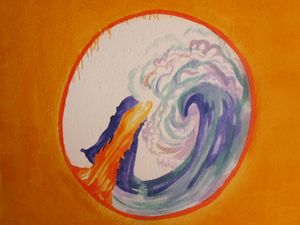
Boiling is a common way of disinfecting water for drinking around the world.[1] The length of boiling time changes not just based on elevation changes, but also based on personal judgments and personal work schedules. Though rainwater is relatively free of impurities there are still points of contamination including fecal material, which have shown up in some studies as coliforms above the recommended level for safe drinking water. This study will compare the effectiveness of E.coli removal at different boiling times from rainwater samples collected in real rainwater catchment systems set up by Isla Urbana in Mexico City. We will compare the effective removal of E.coli at different boiling times commonly used in the community and the boiling time suggested for our elevation at 8,000ft. Samples will be taken from at least 25 random sites among Isla Urbana's systems. Results will be compared with water portability standards set by the World Health Organization to see which ending samples are potable and at what recommended boiling time. Rainwater, Boiling water, water quality, coliforms, contamination, potability, Mexico City
Equipment[edit | edit source]
- 5 500ml sample containers at least
- Icebox for storing fresh samples
- Ice to put in icebox
- 5 gallon pot with secure lid
- Thermometer, to record room temperature
- Stove
- tongs or ladel to scoop out sample jars
- cleaning agents including acetone
- equipment and reagents as specified in the colorimeter manual for E.coli
Sample sites[edit | edit source]
- Faucet, connected to rainwater catchment system
Process[edit | edit source]
- Ask family if cistern has municipal water in it and rainwater, only municipal water, or just rainwater.
- If it is either a mixture of municipal water with rainwater or just rainwater continue to collect the rainwater sample in a 500ml container from the faucet
- Label the sample, write down the date, and write down what the faucet is used for, washing clothes, kitchen prep, etc.
- Place the container in a freezer box full of ice until you can either test the sample or until you can place it in a refrigerator.
- Coliform sampling requires testing within 6 hours of taking the sample.
- Take samples from at least 25 different systems at random selection.
- Test all the initial samples for their level of E. coli within 6 hours of taking sample before boiling, these instructions can be found in the colorimeter manual.(Sampling can be done in sequences of 5 in order to ensure that they can be tested within 6 hours)
- Record your results for the initial samples before boiling.
- Record room temperature.
- Then boil the first 5 sealed samples for 5 minutes with lid on top of pot, record the amount of time to get to boiling. If using an electric or gas stove try to keep the same setting of heat strength for each of the following tests.
- Retest these samples for theirE. coli levels and record the results
- Wait until pot has cooled to room temperature before reusing for next test, record room temperature.
- Boil the next 5 sealed samples for 10 minutes with lid on top of pot
- Retest these samples for their E.coli levels and record the results.
- Wait until pot has cooled to room temperature before reusing for next test, record room temperature.
- Boil the next 5 sealed samples for 13 minutes with lid on top of pot
- Retest these samples for their E.coli levels and record the results
- Wait until pot has cooled to room temperature before reusing for next test, record room temperature.
- Then boil the next 5 sealed samples for 15 minutes with lid on top of pot
- Retest these samples for their E. coli levels and record the results
- Wait until pot has cooled to room temperature before reusing for next test, record room temperature.
- Then boil the last 5 sealed samples for 20 minutes with lid on top of pot
- Retest these samples for their E.coli levels and record the results
- Reagents used in the testing may be toxic and will need careful disposal, check the colorimeter manual for proper disposal and check Section 3 for locations and contact information for the proper disposal organizations in Mexico City.
Hypothesis:
It should only be 12 minutes to boil at our elevation of 7,350 ft. Also though at this time most of the coliforms should be dead and meet EPA potability standards, girardia organisms will still persist in the water. The tough cysts of giardia can only be filtered out, destroyed with extreme temperatures beyond boiling, or destroyed with chemical treatment.[2]
References[edit | edit source]
- ↑ World Health Organization.
- ↑ Andrew Vavrek, Water. http://weblife.org/water.html